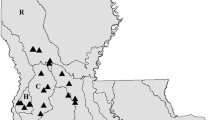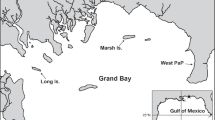Abstract
We estimated whether the fish assemblages nearshore represented by electrofishing and gillnetting indexed location of reservoirs in a river basin. We expected that location in the basin would reflect a multiplicity of factors that determine fish habitat and fish assemblage composition, and therefore also anticipated a correlation between fish species composition and spatial variables if the gear type reflected legitimate differences in fish assemblages. We collected 1.6 million fish of 129 species in 22 reservoirs of the Tennessee River basin, USA. Standardized electrofishing represented different aspects of the fish assemblages than standardized gillnetting. Nevertheless, the assemblages documented by each gear type were correlated with the spatial location of the reservoirs in the river basin. Thus, even as these gear types reflected different aspects of existing fish assemblages, they each tracked spatial differences, suggesting that they reflected standing fish assemblages. Our study supports the use of standardized boat electrofishing and gillnetting as proper means for monitoring fish assemblages at large spatial scales. Our results further suggest that a well-designed and standardized sampling protocol can in fact provide an informative bird’s eye view of fish assemblages at regional, national, or continental scales suitable for informing conservation programs.





Similar content being viewed by others
References
Agostinho AA, Pelicice FM, Gomes LC (2008) Dams and the fish fauna of the Neotropical region: impacts and management related to diversity and fisheries. Braz J Biol 68:1119–1132
Barbosa FAR, Padisak J, Espindola ELG, Rocha BG, O, (1999) The cascading reservoir continuum concept (CRCC) and its application to the River Tietê, São Paulo State, Brazil. In: Tundisi JG, Straškraba M (eds) Theoretical reservoir ecology and its applications. Backhuys Publishers, Leiden, pp 425–436
Bonar SA, Hubert WA, Willis DW (2009) Standard methods for sampling North American freshwater fishes. American Fisheries Society, Bethesda
Bradie J, Pietrobon A, Leung B (2015) Beyond species-specific assessments: an analysis and validation of environmental distance metrics for non-indigenous species risk assessment. Biol Invasions 17:3455–3465
Casselman JM, Penczak T, Carl L, Mann RHK, Holčík J, Woitowich WA (1990) An evaluation of fish sampling methodologies for large river systems. Polskie Archiwum Hydrobiologii 37:521–551
CEN (2002) Water quality—sampling of fish with electricity. European Committee for Standardization EN14011
CEN (2005) Water quality—sampling of fish with multi-mesh gillnets. European Committee for Standardization EN 14757
Clarke KR, Somerfield PJ, Chapman MG (2006) On resemblance measures for ecological studies, including taxonomic dissimilarities and a zero-adjusted Bray-Curtis coefficient for denuded assemblages. J Exp Mar Bio Ecol 330:55–80
Clarke KR, Gorley RN (2015) PRIMER v7: user manual/tutorial. PRIMER-E, Plymouth, UK
Dunn CG, Paukert CP (2020) A flexible survey design for monitoring spatiotemporal fish richness in rivers: optimizing efficiency by integrating gears. Can J Fish Aquat Sci 77:978–990
dos Santos NCL, de Santana HS, Ortega JCG, Dias RM, Stegmann LF, da Silva Araújo IM, Severi W, Bini LM, Gomes LC, Agostinho AA (2017) Environmental filters predict the trait composition of fish communities in reservoir cascades. Hydrobiologia 802:245–253
Eggleton MA, Jackson JR, Lubinski BJ (2010) Comparison of gears for sampling littoral-zone fishes in floodplain lakes of the lower White River, Arkansas. N Am J Fish Manag 30:928–939
Erős T, Specziár A, Bíró P (2009) Assessing fish assemblages in reed habitats of a large shallow lake—a comparison between gillnetting and electric fishing. Fish Res 96:70–76
Etnier DA, Starnes WC (1993) The Fishes of Tennessee. The University of Tennessee Press, Knoxville, Tennessee, USA
Fernando CH, Holčík J (1982) The nature of fish community: a factor influencing the fishery potential and yields of tropical lakes and reservoir. Hydrobiologia 97:127–140
Fischer JR, Quist MC (2014) Characterizing lentic freshwater fish assemblages using multiple sampling methods. Environ Monit Assess 186:4461–4474
Frimpong EA, Angermeier PL (2009) Fish traits: a database of ecological and life-history traits of freshwater fishes of the United States. Fisheries 34:487–495
Gibson-Reinemer DK, Ickes BS, Chick JH (2017) Development and assessment of a new method for combining catch per unit effort data from different fish sampling gears: multigear mean standardization (MGMS). Can J Fish Aquat Sci 74:8–14
Goffaux D, Grenouillett G, Kestemont P (2005) Electric fishing versus gillnet sampling for the assessment of fish assemblages in large rivers. Arch Hydrobiol 162:73–90
Growns IO, Pollard DA, Harris JH (1996) A comparison of electric fishing and gillnetting to examine the effects of anthropogenic disturbance on riverine fish communities. Fish Manag Ecol 3:13–24
Hughes RM, Peck DV (2008) Acquiring data for large aquatic resource surveys: the art of compromise among science, logistics, and reality. J N Am Benthol Soc 27:837–859
Kashiwagi MT, Miranda LE (2009) Influence of small impoundments on habitat and fish communities in headwater streams. Southeast Nat 8:23–36
Kremen C (1992) Assessing the indicator properties of species assemblages for natural areas monitoring. Ecol Appl 2:203–217
Loisl F, Singer G, Keckeis H (2014) Method-integrated fish assemblage structure at two spatial scales along a free-flowing stretch of the Austrian Danube. Hydrobiologia 729:77–94
Loures RC, Pompeu PS (2018) Long-term study of reservoir cascade in south-eastern Brazil reveals spatio-temporal gradient in fish assemblages. Mar Freshw Res 69:1983–1994
Miranda LE, Boxrucker J (2009) Warmwater fish in large standing waters. In: Bonar SA, Hubert WA, Willis DW (eds) Standard methods for sampling North American freshwater fishes. American Fisheries Society, Bethesda, Maryland, pp 29–42
Miranda LE, Dembkowski DJ (2016) Evidence for serial discontinuity in the fish community of a heavily impounded river. Riv Res Appl 32:1187–1195
Miranda LE, Habrat M, Miyazono S (2008) Longitudinal gradients along a reservoir cascade. Trans Am Fish Soc 137:1851–1865
Miranda LE, Lakin KM, Faucheux NM (2021) Habitat associations of black bass in a reservoir system. Trans Am Fish Soc. https://doi.org/10.1002/tafs.10302
Menezes RF, Borchsenius F, Svenning JC, Søndergaard M, Lauridsen TL, Landkildehus F, Jeppesen E (2013) Variation in fish community structure, richness, and diversity in 56 Danish lakes with contrasting depth, size, and trophic state: does the method matter? Hydrobiologia 710:47–59
Ravn HD, Lauridsen TL, Jepsen N, Jeppesen E, Hansen PG, Hansen JG, Berg S (2019) A comparative study of three different methods for assessing fish communities in a small eutrophic lake. Ecol Freshw Fish 28:341–352
Reis EG, Pawson MG (1999) Fish morphology and estimating selectivity by gillnets. Fish Res 39:263–273
Stein A, Gerstner K, Kreft H, Arita H (2014) Environmental heterogeneity as a universal driver of species richness across taxa, biomes and spatial scales. Ecol Lett 17:866–880
Sutela T, Rask M, Vehanen T, Westermark A (2008) Comparison of electrofishing and NORDIC gillnets for sampling littoral fish in boreal lakes. Lakes Reservoirs Res Manage 13:215–220
Weaver MJ, Magnuson JJ, Clayton MK (1993) Analyses for differentiating littoral fish assemblages with catch data from multiple sampling gears. Trans Am Fish Soc 122:1111–1119
Winston MR, Taylor CM, Pigg J (1991) Upstream extirpation of four minnow species due to damming of a prairie stream. Trans Am Fish Soc 120:98–105
Acknowledgements
We thank Dan Dembkowski, Corey Dunn, and two anonymous reviewers for taking time to provide constructive suggestions. Any use of trade, firm, or product names is for descriptive purposes only and does not imply endorsement by the U.S. Government.
Funding
Not applicable.
Author information
Authors and Affiliations
Corresponding author
Ethics declarations
Conflict of interest
The authors declare that they have no known conflicts or competing financial interests.
Data availability
Data belongs to the Tennessee Valley Authority and may be made available on a reasonable request.
Additional information
Publisher's Note
Springer Nature remains neutral with regard to jurisdictional claims in published maps and institutional affiliations.
Rights and permissions
About this article
Cite this article
Miranda, L.E., Faucheux, N.M. & Lakin, K.M. Fishing gear performance nearshore is substantiated by spatial analyses. Rev Fish Biol Fisheries 31, 977–987 (2021). https://doi.org/10.1007/s11160-021-09683-7
Received:
Accepted:
Published:
Issue Date:
DOI: https://doi.org/10.1007/s11160-021-09683-7




